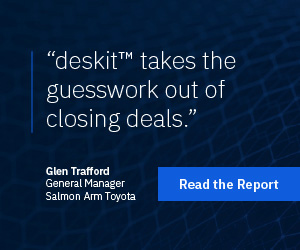The head of Mercedes-Benz in Canada talks about the company’s new product mix, the changing role of the salesperson and the changing consumer.

Canadian auto dealer traveled to Mercedes-Benz Canada’s headquarters in Toronto, Ont. for a one-on-one interview with the President and CEO, Tim Reuss. Here’s part of the conversation with our columnist and automotive journalist Petrina Gentile. You can watch the full interview at www.canadianautomotivevideo.com.
PG: “Your product portfolio has undergone a major overhaul – tell me what’s coming down the pipeline this year?”
TR: “We just announced three new products at the Toronto Auto Show. First up, the AMG GT — a true sports car from Mercedes-Benz. We have the Mercedes-Maybach, the pinnacle of our S-Class, the GLE coupe, a brand new vehicle for us in a brand new segment, which will be coming in August. Then, we have the brand new Smart, which will also be coming in August. We’ll be doing the North American launch at the New York Auto Show. And last but not least, a new addition to our van family — the Metris, which is a smaller van than the Sprinter. All of those products are coming this year.”
PG: ”Is the new Mercedes-Benz C-Class plug-in hybrid coming to Canada?
TR: “We haven’t taken a final decision on that, yet. The main reason is we need it as a 4Matic. We have seen that 4WD is one of the key product drivers for our success in Canada. Currently, the plug-in hybrid on the C-Class is not yet planned with a 4WD. But we have another product that will be coming with 4WD this year that we are definitely looking at also offering with a plug-in hybrid. I’m talking about the new GLK, which we will also be bringing out towards the end of the year.”
PG: “When it comes to green technology which is the way to go: diesel, hybrid, all-electric?”
TR: “We feel for us in Canada it’s a combination. We’ve been extremely successful with diesel in Canada. Our diesel take rate on our SUVs is close to 75-80 per cent versus 10-12 per cent in other countries. Canadians get diesel. They understand it. They know how it works and the benefits that it offers. For driving dynamics, it’s exactly what the market required. Having said that, plug-in hybrids will also offer us another alternative. And then pure-electric vehicles like the Smart, especially for metropolitan areas, are also part of the equation. Personally, I don’t think there’s one answer. It’s going to be a combination of all of those technologies. By the way, long term there’s another very important technology aspect with a Canadian component, which is fuel cell. We are currently producing fuel cell stacks out of Burnaby and Vancouver right here in Canada. So that’s another technology we can see playing a role going forward.”
PG: “When will we see fully autonomous cars, like your F015 concept shown at the 2015 Detroit Auto Show, on the road?”
TR: “We set a proof point of what technology is already possible in the market place. I don’t think we’re going to see fully autonomous cars on the road soon. What we’re currently seeing already is a lot of these assistance systems coming into our vehicles. If you take our S-Class, for instance, it can already do more than the law will actually allow. This is also a lockstep that needs to start happening in the industry between what’s technically possible on our vehicles and what the legislation currently allows.”
PG: “How has the role of the salesperson changed over the years?”
TR: “The job profile of the salesperson at the dealership is changing. 67 per cent of the people who walk into a dealership have already made up their mind on what they’re going to buy. By the way, 90 per cent of them walk out of the showroom with whatever product they made up their mind to buy. So, it’s no longer the job of the salesperson to say, ‘You want a Mercedes then — which one would it be?’ One, two, three and go through all the options. Now the customer comes in and has already made up their mind to buy a new C-Class so you have to walk through the different options with the customer, see what the payment plan could look like, and what accessories they want. The role of the salesperson has completely changed. And it might be, if it’s a junior salesperson, the customer coming in might even know a lot more about the product than a salesperson that started a couple of months ago. Our job as a manufacturer is to try and bridge that knowledge gap as best we can by putting as much information as we can into the hands of our salespeople, our sales organization, and our dealership.”
PG: “Does this threaten the traditional role of the dealership?”
TR: “Customers are doing a lot more of their research online and even some of their transactions online. But at the end of the day people still want to touch a car before they take delivery. For a lot of people, this is probably their second most important purchase in their life after a home so people will still want to touch, feel, and test drive a vehicle before putting their final signature on the paper. But having said that the process to get there is definitely changing and online is playing a much, much bigger role in it.”
PG: “Are there any plans for Mercedes-Benz to expand its manufacturing footprint in North America?”
TR: “We are constantly analyzing the production capacity that we gave in our worldwide footprint. North America is definitely one of our strongest markets today and we foresee that it will continue to be a very strong market for us in the future. If we come to the conclusion that we need additional production capacity in North America we would announce it at that said point of time.”


















